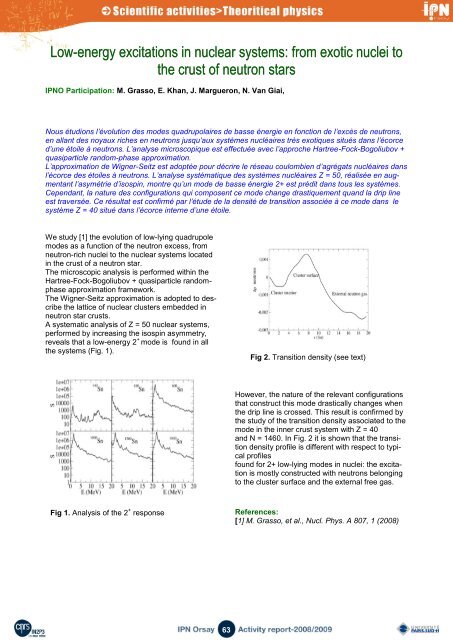exotic nuclei structure and reaction noyaux exotiques ... - IPN - IN2P3
exotic nuclei structure and reaction noyaux exotiques ... - IPN - IN2P3
exotic nuclei structure and reaction noyaux exotiques ... - IPN - IN2P3
You also want an ePaper? Increase the reach of your titles
YUMPU automatically turns print PDFs into web optimized ePapers that Google loves.
Low-energy excitations in nuclear systems: from <strong>exotic</strong> <strong>nuclei</strong> to<br />
the crust of neutron stars<br />
<strong>IPN</strong>O Participation: M. Grasso, E. Khan, J. Margueron, N. Van Giai,<br />
Nous étudions l’évolution des modes quadrupolaires de basse énergie en fonction de l’excès de neutrons,<br />
en allant des <strong>noyaux</strong> riches en neutrons jusqu’aux systèmes nucléaires très <strong>exotiques</strong> situés dans l’écorce<br />
d’une étoile à neutrons. L’analyse microscopique est effectuée avec l’approche Hartree-Fock-Bogoliubov +<br />
quasiparticle r<strong>and</strong>om-phase approximation.<br />
L’approximation de Wigner-Seitz est adoptée pour décrire le réseau coulombien d’agrégats nucléaires dans<br />
l’écorce des étoiles à neutrons. L’analyse systématique des systèmes nucléaires Z = 50, réalisée en augmentant<br />
l’asymétrie d’isospin, montre qu’un mode de basse énergie 2+ est prédit dans tous les systèmes.<br />
Cependant, la nature des configurations qui composent ce mode change drastiquement qu<strong>and</strong> la drip line<br />
est traversée. Ce résultat est confirmé par l’étude de la densité de transition associée à ce mode dans le<br />
système Z = 40 situé dans l’écorce interne d’une étoile.<br />
We study [1] the evolution of low-lying quadrupole<br />
modes as a function of the neutron excess, from<br />
neutron-rich <strong>nuclei</strong> to the nuclear systems located<br />
in the crust of a neutron star.<br />
The microscopic analysis is performed within the<br />
Hartree-Fock-Bogoliubov + quasiparticle r<strong>and</strong>omphase<br />
approximation framework.<br />
The Wigner-Seitz approximation is adopted to describe<br />
the lattice of nuclear clusters embedded in<br />
neutron star crusts.<br />
A systematic analysis of Z = 50 nuclear systems,<br />
performed by increasing the isospin asymmetry,<br />
reveals that a low-energy 2 + mode is found in all<br />
the systems (Fig. 1).<br />
Fig 2. Transition density (see text)<br />
However, the nature of the relevant configurations<br />
that construct this mode drastically changes when<br />
the drip line is crossed. This result is confirmed by<br />
the study of the transition density associated to the<br />
mode in the inner crust system with Z = 40<br />
<strong>and</strong> N = 1460. In Fig. 2 it is shown that the transition<br />
density profile is different with respect to typical<br />
profiles<br />
found for 2+ low-lying modes in <strong>nuclei</strong>: the excitation<br />
is mostly constructed with neutrons belonging<br />
to the cluster surface <strong>and</strong> the external free gas.<br />
Fig 1. Analysis of the 2 + response<br />
References:<br />
[1] M. Grasso, et al., Nucl. Phys. A 807, 1 (2008)<br />
63

















